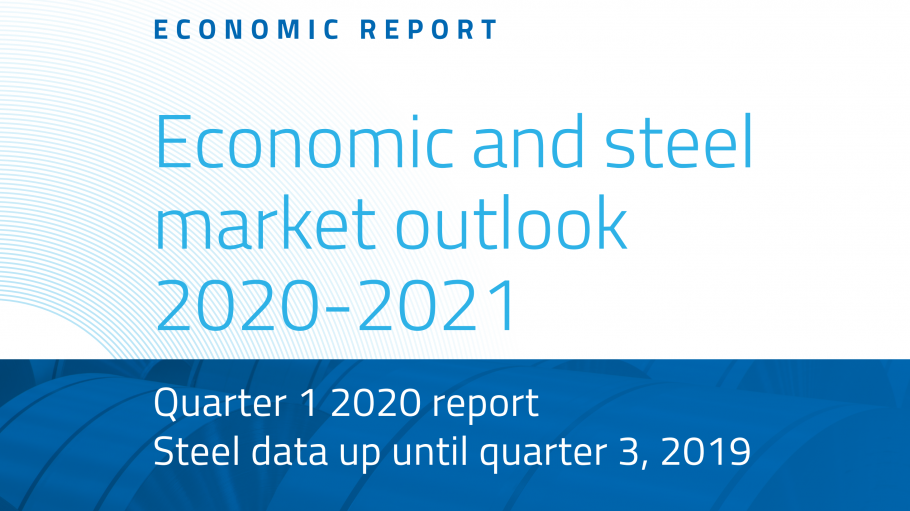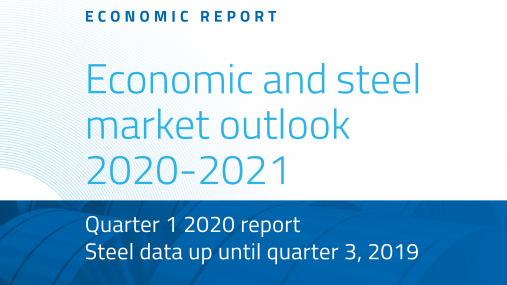
Press releases » Volatility defines steel markets in 2019; challenges continue into 2020 even as demand stabilises
Volatility defines steel markets in 2019; challenges continue into 2020 even as demand stabilises
Downloads and links
Recent updates

Brussels, 30 January 2020 – Apparent steel consumption fell by 3.1% year-on-year in the third quarter of 2019, a slight moderation compared to the drop recorded in the second quarter (-6.7%). The ongoing negative trend in steel demand is the result of the continued slump in EU’s manufacturing sector due to weakened exports and investment that has become more pronounced during the second and third quarter of 2019. Leading indicators suggest that the downturn continued in the remainder of 2019, albeit with some signs of stabilisation. No significant rebound is forecast before the second half of 2020.
The current downturn of the manufacturing sector in the EU is not likely to bottom out in the very short-term. Major risk factors are escalating trade wars between the US and several of its main trading partners (mostly China, despite the trade agreement signed on 15 January 2020 that has eased frictions) and persistent uncertainty regarding the final Brexit deal to be agreed by the end of 2020. These factors are set to weigh on trade conditions during 2020, and may even lead to a further deterioration in business sentiment and seriously hamper investment growth. In this scenario, the EU steel sector would continue to be severely impacted, also having to cope with growing import distortions as well as persistently high import volatility as a result of the increase in the safeguard quotas and transfer mechanism of unused quarterly quota.
“2019 was another challenging year for the steel sector, with declines in steel consumption and import levels which – while down compared to 2018 – were still very high compared to historical levels”, said Axel Eggert, Director General of the European Steel Association (EUROFER). “While some growth is expected to return to steel markets in 2020, even these modest estimations could be upended if events take an unexpected turn”.
EU steel market overview
EU28 apparent steel consumption fell by 3.1% year-on-year in the third quarter of 2019 and amounted to 37.2 million tonnes. The stock cycle continued to be negative, which further impacted on the negative trend in final steel use. In fact, ongoing uncertainty about near-term business conditions as well as relatively high stock levels at the end of the first quarter of 2019 had triggered a steeper-than-expected stock reduction in the second quarter – contrary to the seasonal pattern - which has continued, albeit to a lower extent, in the third quarter.
The current downturn in steel demand led to a fall of 4% year-on-year in domestic deliveries in the EU in the third quarter of 2019, following a decrease of 3% in the first quarter. After the exceptional drop of 19% year-on-year experienced in the second quarter, third country imports decreased only marginally in the third quarter (by 1%), and amounted to 8.8 million tonnes, accounting for 23.8% of EU steel demand. Monthly data continued to show high volatility.
As in previous quarters, developments in total imports conceal distortions at the individual product level, which are, in essence, reflecting the flaws of the current safeguard mechanism, and which have resulted in a rush to maximise quarterly quota allowances by several key exporters to the EU such as Turkey and China.
During the third quarter of 2019, the challenges that the EU sector has had to face have become even more severe, with negative repercussions on market conditions. After recording falls over the first two quarters of 2019, the negative trend in real steel consumption accelerated and early indications for the final quarter of 2019 signal a further year-on-year reduction, resulting in a total decrease in real steel consumption by 1.1% over the whole year 2019. Real consumption levels are expected to recover in the second half of 2020 but also to stabilise around low levels in historical terms. The expected fall in apparent steel consumption in 2019 of 3.3% year-on-year and persisting import pressure is, in essence, expected to mostly have penalised EU steel producers in their business performance.
Market conditions are expected to improve slightly from the third quarter of 2020, although risks related to import distortions and continued global overcapacity are likely to continue undermining the stability of the EU steel market. In particular, global steel capacity has continued to increase and the gap between capacity and production has been widening in recent months.
Apparent consumption is expected to recover in 2020 with a growth rate of 1.2%, basically as a result of a modest re-stocking rather than as a result of a rebound in demand from steel-using sectors.
EU steel-using sectors
Business conditions in the manufacturing industry have continued to deteriorate since the peak of the previous cycle, around the end of 2017. This downward trend has become steeper in the second quarter of 2019, particularly in the automotive industry, and has also continued in the third quarter, albeit to a slightly lower extent. The construction sector has continued to record growth in output and has outperformed other steel-using sectors. As a result, output growth in the steel-using sectors has been slowing down since the first quarter of 2018, culminating in a year-on-year fall of 0.4% in the second quarter of 2019, followed by a meagre recovery of 0.2% year-on-year in the third quarter.
The downturn in industrial activity does not only affect Europe, but also is manifested at the global level, reflecting growing trade frictions and uncertainty – which has increasingly hampered business investment. Although a substantial rebound is not in sight in the short-term, some recovery in EU steel-using sectors is expected over the course of 2020.
External risks are likely to continue to cast a shadow over the coming quarters. Global trade tensions have eased thanks to the US-China agreement that has been signed on 15 January, thus avoiding a negative spiral of retaliation further to the US Administration’s new tariffs on goods imported from its main trading partners. However, the EU’s manufacturing sector is still undergoing a serious downturn, given its large exposure to global trade. A no-deal Brexit by the end of 2020 – which is theoretically still possible - and a new escalation in protectionist trade measures, coupled with possible geopolitical tensions in the Middle East (Iran, Iraq, Libya) would further contribute to curbing business confidence and activity in steel-using industries.
Output in the EU’s steel-using sectors is forecast to remain unchanged in 2019 and to grow and by 0.6% in 2020 and 1.4% in 2021.
***
Contact
Charles de Lusignan, Head of Communications, +32 2 738 79 35, (charles@eurofer.be)
About the European Steel Association (EUROFER)
EUROFER AISBL is located in Brussels and was founded in 1976. It represents the entirety of steel production in the European Union. EUROFER members are steel companies and national steel federations throughout the EU. The major steel companies and national steel federations in Switzerland and Turkey are associate members.
About the European steel industry
The European steel industry is a world leader in innovation and environmental sustainability. It has a turnover of around €170 billion and directly employs 330,000 highly-skilled people, producing on average 160 million tonnes of steel per year. More than 500 steel production sites across 22 EU Member States provide direct and indirect employment to millions more European citizens. Closely integrated with Europe’s manufacturing and construction industries, steel is the backbone for development, growth and employment in Europe.
Steel is the most versatile industrial material in the world. The thousands of different grades and types of steel developed by the industry make the modern world possible. Steel is 100% recyclable and therefore is a fundamental part of the circular economy. As a basic engineering material, steel is also an essential factor in the development and deployment of innovative, CO2-mitigating technologies, improving resource efficiency and fostering sustainable development in Europe.

Download files or visit links related to this content
Letter to Commission President von der Leyen and Executive Vice-President Sejourne'
Brussels, 27 November 2024 – The European steel industry is at a critical juncture, facing irreversible decline unless the EU and Member States take immediate action to secure its future and green transition. Despite repeated warnings from the sector, the EU leadership and governments have yet to implement decisive measures to preserve manufacturing and allow green investments across Europe. Recent massive production cuts and closure announcements by European steelmakers show that time has run out. A robust European Steel Action Plan under an EU Clean Industrial Deal cannot wait or manufacturing value chains across Europe will simply vanish, warns the European Steel Association.
Brussels, 12 November 2024 - Ahead of Commissioner-Designate Séjourné’s hearing in the European Parliament, European steel social partners, supported by cross-party MEPs, jointly call for an EU Steel Action Plan to restore steel’s competitiveness, and save its green transition as well as steelworkers’ jobs across Europe.